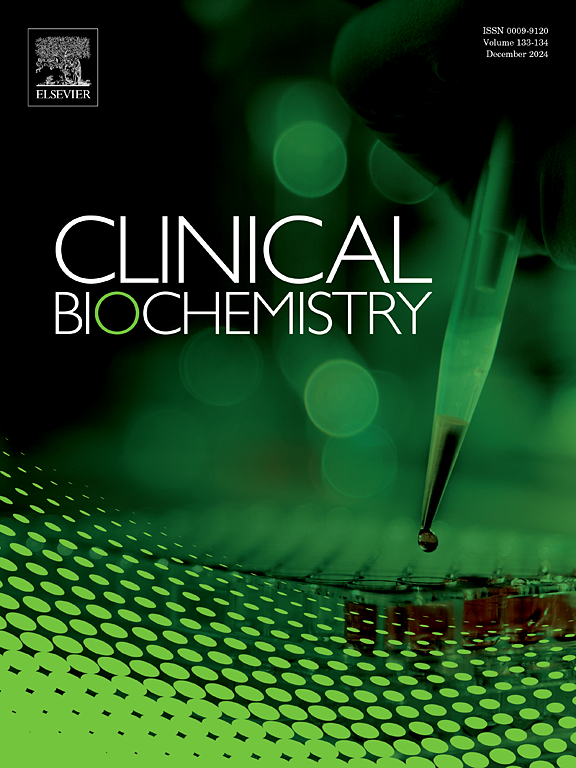一种新的可溶性转铁蛋白受体测定方法的评价和三种测量方法的比较。
IF 2.5
3区 医学
Q2 MEDICAL LABORATORY TECHNOLOGY
引用次数: 0
摘要
背景:可溶性转铁蛋白受体(sTfR)是鉴别贫血的有用标志物。临床应用受到测量程序和解释性建议之间缺乏标准化的限制。我们的目的是评估研究sTfR免疫比浊法(Alinity c, Abbott Diagnostics)的分析性能,并将其与三种已建立的测量程序进行比较。方法:在整个分析测量区间内用7个面板评估分析不精密度。159例患者样本通过四种仪器系统(Alinity c [Abbott Diagnostics]、Tina-quant c502 [Roche Diagnostics]、Quantex Biokit [Werfen]和ACCESS [Beckman Coulter])进行测量。测定铁蛋白以计算sTfR/Log铁蛋白比率。测定100例参考个体血清的sTfR和铁蛋白(aliniity),用于验证参考区间(RI) (sTfR)或建立参考区间(sTfR指数)。结果:测定不精密度达到规定目标。Alinity c和ACCESS sTfR检测结果一致(斜率:1.06,截距:-0.12,r: 0.989)。其他试验的比较显示出显著的比例偏差,斜率范围从0.44 (Tina-quant c502,平均偏差:-2.52 mg/L)到1.24 (Quantex Biokit,平均偏差:0.60 mg/L)。在其他仪器之间观察到比例偏差。虽然在Alinity检测中验证了sTfR RI,但Alinity与其他平台之间的解释一致性(在RI内与外部)范围为74.2-80.5 %。结论:我们报告了研究sTfR免疫比浊测定性能的第一个特征(Alinity c, Abbott Diagnostics)。我们的研究结果强调了sTfR和sTfR指数的测量程序和结果解释之间缺乏一致性,需要标准化工作和临床研究。本文章由计算机程序翻译,如有差异,请以英文原文为准。
Evaluation of a new soluble transferrin receptor assay and comparison to three measurement procedures
Background
Soluble transferrin receptor (sTfR) is a useful marker in the differentiation of anemia. Clinical utility is limited by lack of standardization between measurement procedures and interpretative recommendations. Our objective was to evaluate the analytical performance of a research sTfR immunoturbidimetric assay (Alinity c, Abbott Diagnostics) and compare it to three established measurement procedures.
Methods
Assay imprecision was assessed with 7 panels across the analytical measuring interval. 159 patient samples were measured across four instrument systems (Alinity c [Abbott Diagnostics], Tina-quant c502 [Roche Diagnostics], Quantex Biokit [Werfen], and ACCESS [Beckman Coulter]). Ferritin was also measured to calculate an sTfR/Log Ferritin ratio. Sera from 100 reference individuals were assayed for sTfR and ferritin (Alinity) for reference interval (RI) verification (sTfR) or establishment (sTfR index).
Results
Assay imprecision met defined goals. Method comparison between Alinity c and ACCESS sTfR assays showed good agreement (slope: 1.06, intercept: −0.12, r: 0.989). Comparisons across other assays demonstrated significant proportional bias with slopes ranging from 0.44 (Tina-quant c502, mean bias: −2.52 mg/L) to 1.24 (Quantex Biokit, mean bias: 0.60 mg/L). A proportional bias was observed between other instruments. While the sTfR RI was verified on the Alinity assay, agreement in interpretation (within vs outside RI) between Alinity and other platforms ranged from 74.2 to 80.5 %.
Conclusion
We report the first characterization of the performance of a research sTfR immunoturbidimetric assay (Alinity c, Abbott Diagnostics). Our findings emphasize the lack of harmonization between measurement procedures and result interpretation for sTfR and sTfR index, necessitating standardization efforts and clinical studies.
求助全文
通过发布文献求助,成功后即可免费获取论文全文。
去求助
来源期刊

Clinical biochemistry
医学-医学实验技术
CiteScore
5.10
自引率
0.00%
发文量
151
审稿时长
25 days
期刊介绍:
Clinical Biochemistry publishes articles relating to clinical chemistry, molecular biology and genetics, therapeutic drug monitoring and toxicology, laboratory immunology and laboratory medicine in general, with the focus on analytical and clinical investigation of laboratory tests in humans used for diagnosis, prognosis, treatment and therapy, and monitoring of disease.
 求助内容:
求助内容: 应助结果提醒方式:
应助结果提醒方式:


